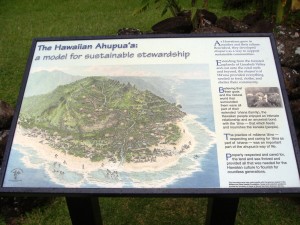Well, maybe. The article in The Monitor is a bit confused. Yes, there are wild rices in Uganda. I know because I was (marginally) involved in the 1997 Sida-IRRI project which collected wild Oryza in Eastern and Southern Africa. The material has been conserved since then in the National Genetic Plant Resources Centre for Crops in Entebbe, and has now been evaluated — successfully, it would seem — for resistance to Yellow Mottle Virus. Which is great. But the crossing with cultivated rice has not started in Uganda, I don’t think. The crosses that are alluded to in the article seem rather to have been between Asian rice and cultivated African rice (Oryza glaberrima), presumably aiming to replicate the success of Nerica in West Africa. Anyway, good luck to Drs John Mulumba Wasswa and Jimmy Lamo with the breeding programme.
Hawaiian agrobiodiversity memories
I came across an evocative little piece in The Garden Island on Sunday, thanks to a Google alert. It’s about an upcoming course on permaculture design that will be looking in depth at the ahupua’a, the old Hawaiian practice of land subdivision and management.
To ensure adequate space for forests and agriculture in each ahupua’a, pre-colonial Hawaiian communities applied careful land-use planning. Valley floors, where the most fertile soil is concentrated, were reserved for agriculture. They often included walled-terraces developed to grow kalo (taro), the most important staple food crop for Hawaiians. Houses were built on hillsides and in sandy areas in order to save prime agricultural lands. As contemporary Kaua’i attempts to move towards more self-sufficient communities, we can look towards this model of reserving prime agricultural lands for agriculture to perpetuate our ability to feed ourselves.
The piece reminded me of a visit I made with the family to the Limahuli Garden and Preserve on Kaua’i. It’s a beautiful place, explicitly organized around the ahupua’a concept.

And it even maintains small collections of different varieties of local root crops such as taro and sweet potato. Which was mainly why I was there. Although the visit came too late to allow me to include the data in the directory of Pacific collections. Maybe the next edition…

Rooting for the tubers
The Root Crops Agrobiodiversity Project in Vanuatu is inventorying varieties in various villages around the archipelago, and coming up with some astonishing results. 1 But, crucially, the work will not stop there. One of the objectives of the project is “to identify new varieties aiming at broadening the existing genetic bases and to propose them to producers and users, taking into account their needs and preferences.” So it’s more than the usual 3Cs — collect-characterize-conserve. There’s also creation, and dissemination, of new diversity, via seed production. That’s not that easy to do with taros and yams, but then, neither is conservation in conventional field and in vitro genebanks. It’s a very sensible idea to get the diversity increasing and moving around, rather than locking it up on research stations.
The Vegetable Garden
Frank Van Keirsbilck wrote to recommend his web site, The Vegetable Garden, to us. I’m happy to link to it. There’s a ton of information there, in four languages. 2 The site looks funky and hand-rolled, which is charming although slightly cumbersome, and you may well find things of interest.
Nibbles: Wolf, Conservation agriculture, ODI, Food policy, Stress, Sustainability
- Evidence of extrogression from dogs. That would be the opposite of introgression, and there are apparently lots of examples from mammals.
- “Conservation agriculture is an essential element of … intensification.†Oh please.
- Simon Maxwell, director of the Overseas Development Institute, on the Millennium Villages etc. Lukewarm, I’d say.
- Louise Fresco makes bread at TED. Fiat Panis, eh?
- India to manage abiotic stresses. I’ve got a few of those I’d like to manage a bit better.
- Arab nations discuss differences of opinion on sustainability. Someone tell me the bottom line.